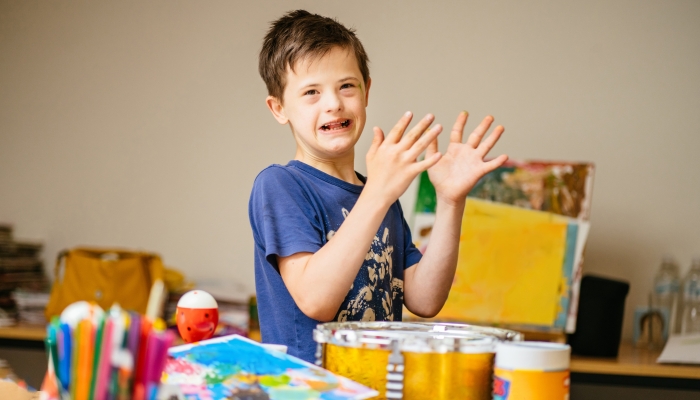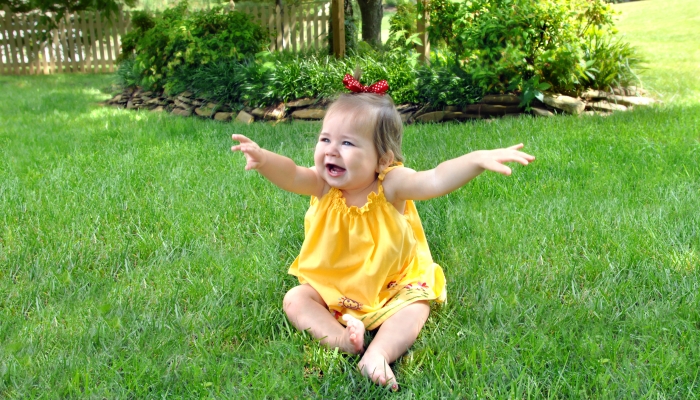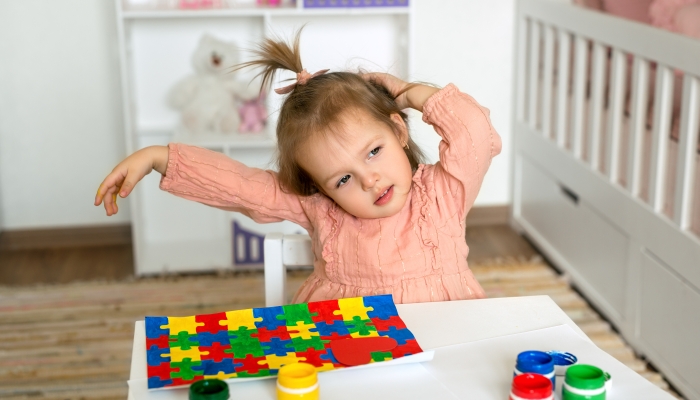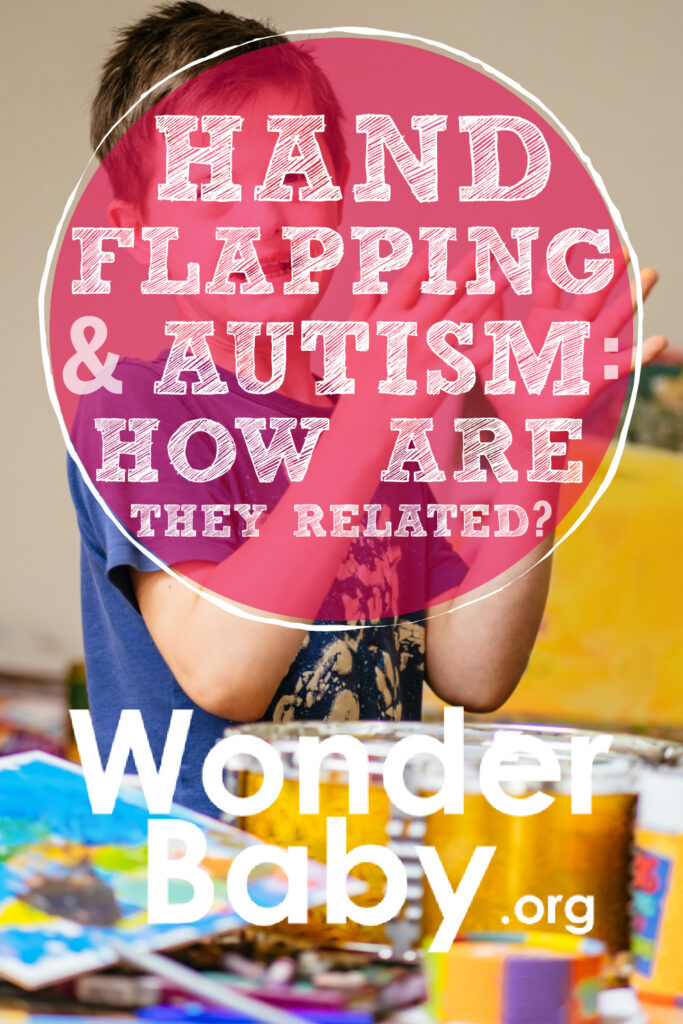Hand Flapping and Autism: How Are They Related?

- Hand flapping is a repetitive shaking of hands that provides sensory stimulation and comfort.
- It’s a type of self-stimulating behavior, also known as stimming. Hand flapping is often seen when your child is feeling a strong emotion such as joy or excitement.
- Repetitive hand movements can be an indicator of autism or other sensory processing needs. Not all children who flap their hands are autistic and not all autistic children hand flap.
- These movements are important for your child’s daily functioning, so we generally do not want to stop or change them.
- Understanding and accepting hand flapping and other self-stimulatory behaviors can help caregivers to provide a supportive environment for their child.
Sitting in a meeting that has overrun, I find myself tapping my foot, twirling my pen, playing with my hair, and doodling. Why? Because I haven’t had enough sensory input, or I’m feeling bored and need to move.
When children flap their hands, it’s usually for a similar reason. They may be anxious, excited, or have another strong emotion, or they may be craving sensory input.
Hand flapping is exactly what it sounds like—a repetitive waving of hands back and forth. Repetitive movements like this can be very helpful for children’s daily functioning. They can even help with avoiding sensory overload.
Think about how helpful fidgeting can be for you!
You might be concerned about your child if you see them flapping their hands and wonder if you need to intervene. In general, hand flapping is a helpful and harmless tool. It helps your child regulate their sensory system and should not be discouraged.
Is Hand Flapping Developmentally Typical in Children?
Hand flapping is often associated with autism. It can sometimes be an indicator of neurodiversity or sensory processing issues.
However, one study published in 2021 by Robin Sifre, PhD, et al. notes that these repetitive movements are often observed in typically developing children too, particularly young infants.
Another study published in Developmental Medicine & Child Neurology by Sylvie Goldman, PhD et al. adds that these motor behaviors “may persist in some toddlers and in some typically developing children or adults who, especially when bored or stressed, still engage in hair twisting, drumming, or other mannerisms.”
It’s important to note that not all individuals with autism engage in hand flapping, and not all children who engage in hand flapping have autism.

Is Hand Flapping Something to Worry About?
Unless your child is hurting themselves or others, hand flapping shouldn’t be an immediate cause for concern.
Infants will often start experimenting with waving their hands as they gain motor control. They may also use movement as an emotional response—like my son who stomps his feet with excitement! As your child gets older, they may continue to use hand flapping to support their sensory processing needs.
Sometimes hand flapping may indicate an additional sensory need and may contribute to a diagnosis.
Experts advise you to not discourage your child from flapping their hands. This is because it’s often used as a self-soothing behavior to regulate their sensory systems.
Is Hand Flapping a Sign of Autism?
People with autism often exhibit hand flapping and other repetitive movements. However, it’s important to note that hand flapping alone is not enough to diagnose autism spectrum disorder.
The standard diagnostic list (often referred to as DSM-5) can be found on CDC’s website. An autistic child would be showing difficulties with social communication and interaction. They may or may not flap their hands or show other “restricted, repetitive patterns of behavior, interests, or activities,” according to the diagnostic criteria.
If there are other signs that your child may have autism spectrum disorder (ASD) or sensory processing disorder (SPD), speak to your healthcare professional.
For an example of children with autism hand flapping, you can watch this video.
How Are Hand Flapping and Autism Related?
Repetitive movements, such as hand flapping, can provide a source of stimulation, comfort, and regulation. Many in the autistic community refer to these movements as stimming. Stimming behaviors can help autistic children to manage their sensory experiences and emotions.
Research by Steven K. Kapp, PhD et al. (2019) found that autistic adults use self-stimulation as a “useful coping mechanism.” Because of this, they “objected to treatment that aims to eliminate the behavior.”
Treatments aiming to reduce stimming behaviors are still widely used. An article by Sydney H. Kinnear et al. published in Journal of Autism and Developmental Disorders in 2016 may have the answer to why this might be. Unfortunately, the stigma around noticeable stimming behavior may make parents feel that they need to try to stop their child from doing it.
What Are Some Other Forms of Self-Stimulatory Behaviors in Autism?
Hand flapping is just one form of self-stimulatory behavior that individuals with autism may engage in. Other common forms of stimming include:
- Vocal stims (repeated verbal noises, humming, grunting)
- Repetitive body movements (rocking back and forth, spinning in circles)
- Flicking or twirling objects
- Head banging
- Visual stimming such as staring blankly or repeated blinking
- Repetitive motion with toys or other objects (e.g. tapping a pencil)
- Olfactory stimming (licking or smelling unusual objects)
Each individual with autism is unique and may exhibit different forms of stimming. It’s also common for children without autism to show these repetitive behaviors.

How Can I Support My Child With Hand Flapping?
It can be difficult to know the best ways to manage repetitive or stereotyped behavior for your child. To support your child with hand flapping, it’s important to understand that it’s a coping strategy your child needs. Accepting and showing understanding of it can help your child feel supported and respected.
In some cases, you may need to gently encourage alternative forms of meeting sensory needs. For example, if:
- Their stimming becomes unsafe for themselves or others
- Your child is becoming distressed by social reactions to their stimming
- Stimming is interfering with daily activities such as sleeping or eating
It’s best to discuss this with your child’s doctor or occupational therapist for a tailored approach.
Here are some further ways you could support your child with their stimming:
Social Stories
Social stories, developed by Carol Gray, can help a child understand situations. They’re an excellent tool for children with autism.
As you know your child best, making your own social story is often the best route for a personalized experience. You can also purchase premade social stories, like this social narrative: I Stim and Stimming Feels Good.
This can help your child to understand why they stim, how other people may react to their stimming, and how they can ensure it’s safe for everyone.
Redirection
Flapping hands is unlikely to cause injury, so doesn’t usually need redirection. If their hands are hitting a person nearby or causing self-injury, you may need to put in place some boundaries or redirect them to a different activity.
As stimming is often a result of a sensory need, sensory toys can provide a helpful redirection tool. If they’re at risk of causing harm because of holding something dangerous while they stim, you could have a soft toy or blanket for them to hold instead. Think about ways to still meet their sensory needs while keeping them safe.
Management of Sensory Input
For children with or without sensory processing disorders, creating a calm environment can be incredibly helpful. Aim to have at least one space in your home free of anything which may trigger stimming as a calm space your child can visit.
Common triggers include bright lights, loud noises, and intense colors. A quiet, plain room can also be a helpful retreat during a sensory meltdown.
One helpful quality of stimming is that it can help you to notice that your child may be stressed or anxious. It’s a good idea to plan alongside your child how to help them when they’re in these moments.
Changing the Narrative
Stimming sometimes only begins to affect your child’s life when other kids make comments or stare at them. It can be challenging when people don’t understand what stimming is or how it helps your child. Stimming has historically been widely misunderstood and unfairly judged.
If you have the opportunity to educate others it can help towards the effort of stimming being more widely recognized as a form of regulating. Perhaps you could ask your child’s school to hold a class about stims and autism or help your child to explain their needs to others. Helping people to understand stimming as similar to fidgeting can be a helpful comparison.
Many autistic adults have found more typically “socially acceptable” ways to stim, such as doodling or tapping their foot. Nobody should feel like they have to change their stimming behaviors unless they’re causing harm, but if your child is struggling with the social reactions to their stimming, they may find an alternative like this helpful.
FAQs
Why do autistic children often flap their hands?
Individuals with autism often display “stereotyped or repetitive motor movements” and “hyper or hyporeactivity to sensory input” as defined in the DSM-5 diagnostic criteria.
Waving hands or other repetitive body movements are self-stimulatory behaviors that help to avoid sensory overload. Many autistic adults describe stimming as helpful, calming, a way to gain a sense of control, and a way to free their minds.
Is stimming the same thing as a tic?
Tics can look similar to stims, and the two may be confused.
The main difference is that stimming is usually voluntary and can be controlled. Tics are always involuntary and generally harder to control. Stimming is also a calming motion, but tics are not.
There are other subtle differences between tics, stimming, and compulsions.
Does stimming stop my child from concentrating at school?
As a teacher, I can appreciate that stimming can be difficult to manage in the classroom, especially if it’s distracting other children.
It might look like your child isn’t concentrating if they’re constantly moving or making sounds. To the contrary, McCarty & Brumback (2021) suggest stimming helps concentration.
Their research found that stimming can improve, “sensory processing, emotional regulation, improved focus, concentration, and attention.”
References
- Centers for Disease Control and Prevention. (n.d.). Diagnostic criteria for autism spectrum disorder. Accessed from: https://www.cdc.gov/ncbddd/autism/hcp-dsm.html
- Goldman, S., Wang, C., Salgado, M.W., Greene, P.E., Kim, M. and Rapin, I. (2009), Motor stereotypies in children with autism and other developmental disorders. Developmental Medicine & Child Neurology, 51: 30-38. doi: 10.1111/j.1469-8749.2008.03178.x Accessed from: https://onlinelibrary.wiley.com/doi/10.1111/j.1469-8749.2008.03178.x
- Kapp SK, Steward R, Crane L, Elliott D, Elphick C, Pellicano E, Russell G. ‘People should be allowed to do what they like’: Autistic adults’ views and experiences of stimming. Autism. 2019 Oct;23(7):1782-1792. doi: 10.1177/1362361319829628. Epub 2019 Feb 28. PMID: 30818970; PMCID: PMC6728747. Accessed from: https://www.ncbi.nlm.nih.gov/pmc/articles/PMC6728747/
- Kinnear, S.H., Link, B.G., Ballan, M.S. et al. Understanding the Experience of Stigma for Parents of Children with Autism Spectrum Disorder and the Role Stigma Plays in Families’ Lives. J Autism Dev Disord 46, 942–953 (2016). doi: 10.1007/s10803-015-2637-9 Accessed from: https://link.springer.com/article/10.1007/s10803-015-2637-9
- McCarty, Meredith J., Audrey C. Brumback, Rethinking Stereotypies in Autism, Seminars in Pediatric Neurology, Volume 38, 2021, 100897, ISSN 1071-9091, doi: 10.1016/j.spen.2021.100897. Accessed from: https://www.sciencedirect.com/science/article/pii/S1071909121000255
- Sifre R, Berry D, Wolff JJ, Elison JT. Longitudinal change in restricted and repetitive behaviors from 8-36 months. J Neurodev Disord. 2021 Jan 11;13(1):7. doi: 10.1186/s11689-020-09335-0. PMID: 33423667; PMCID: PMC7798225. Accessed from: https://www.ncbi.nlm.nih.gov/pmc/articles/PMC7798225/

Related Posts

Eye Conditions and Syndromes, Visual Impairment
Neuralink Announces Plans to Restore Sight to the Blind with Brain Chip
Elon Musk’s company Neuralink has announced plans to begin human trials of its new “Blindsight” brain chip by the end of 2025.

Special Needs
5 Spring Cleaning Tips for Families of Children with Disabilities
Spring cleaning is an opportunity to create a more accessible, organized, and supportive space for your child with disabilities. Declutter, deep clean, and refresh!

Visual Impairment
The Gift of Understanding: How a Young Child Helps His Blind Father Navigate Life
When a parent is blind, it’s natural for people to wonder how their sighted child will adapt. Will they struggle to understand their parent’s needs? Will they feel burdened by...